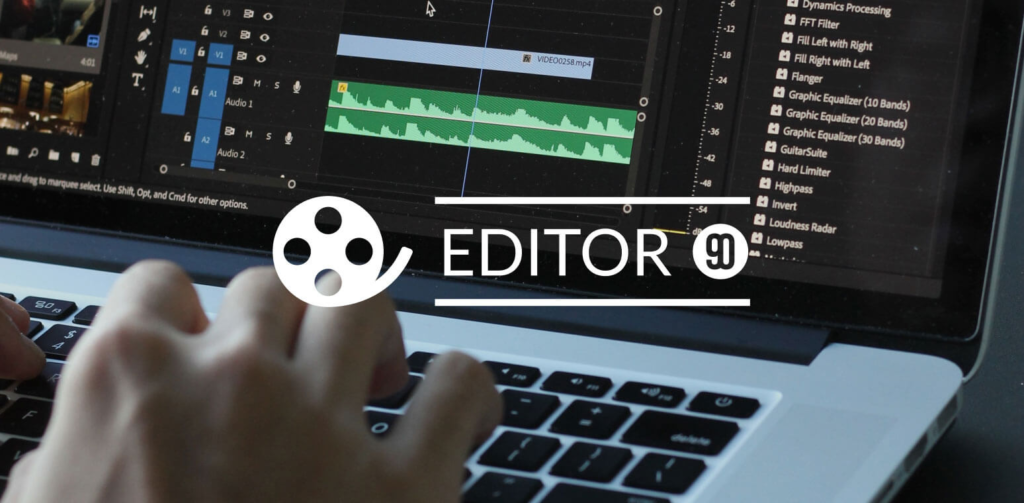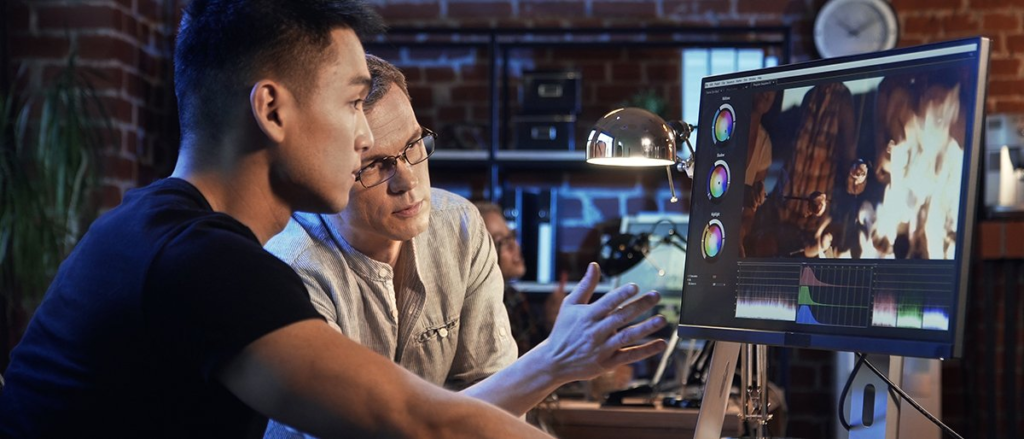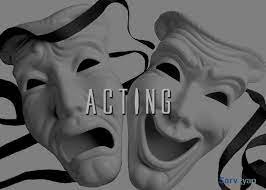Editor (1 years diploma)
Editor click here
Brief Job Description: Individuals at this job need to understand, cut/ re-cut,
assemble and merge production raw material (such as footage, music, sound and
images) into a sequential final output suitable for broadcasting
.
Personal Attributes: This job requires the individual to be well-versed with
editing conventions and techniques such as sorting, assembling, parallel editing,
splicing and joining, merging and synchronizing picture/sound. The individual
must be able to prepare the final output using editing software such as Avid, Final
Cut Pro, After Effects, Adobe Premiere and sound cleaning software.

Qualifications Pack For Editor
Keywords /Terms Description
Budget Budget is an estimate of the total cost of production that may include a
break-up of cost components
Colour grading Colour grading is the process of modifying/enhancing the colour of
productions
Compositing Compositing is the process of combining layers of images/elements into a
single frame
Computer-generated
effects
Computer-generated effects is the process of creating illusionary images
for use in productions
Creative Brief Creative brief is a document that captures the key questions that serve as
a guide for the production including the vision, objective of the project,
target audience, timelines, budgets, milestones, stakeholders etc.
Digital Intermediate Digital Intermediate is the process of altering the colour characteristics of
a digital version of the production
Editing Editing is the process of organizing, cutting and putting together audio,
visual footage to prepare an accurate, condensed and consistent final
output that communicates the expected content
Footage Recorded medium in any media
Ingest Ingest is the process of importing the relevant audio visual files and/or
images to the computer’s hard disk and uploading them to the editing
software
Modeling Modeling is the process of creating three-dimensional models for
animation using a specialised software application.
Rendering Rendering is the process of converting three-dimensional models into
two-dimensional images with 3D effects
Rotoscopy Rotoscopy is the process of breaking down content into individual
frames, tracing out individual images and altering content according to
requirements
Screen conversion Screen conversion is the process of conversion from 2D to 3D
Sound editing Editing of sound materials with/ without visuals
Visual effects Visual effects is the process of integrating live-action footage with
computer-generated effects
Timelines It is a basic part of editing software to view/ cut material
Sector Sector is a conglomeration of different business operations having similar
businesses and interests. It may also be defined as a distinct subset of the
economy whose components share similar characteristics and interests.
Sub-sector Sub-sector is derived from a further breakdown based on the
characteristics and interests of its components.
Vertical Vertical may exist within a sub-sector representing different domain
areas or the client industries served by the industry.

Occupation Occupation is a set of job roles, which perform similar/related set of
functions in an industry
Function Function is an activity necessary for achieving the key purpose of the
sector, occupation, or area of work, which can be carried out by a person
or a group of persons. Functions are identified through functional
analysis and form the basis of OS
Sub-functions Sub-functions are sub-activities essential to ful fill the achieving the
objectives of the function.
Job role Job role defines a unique set of functions that together form a unique
employment opportunity in an organization.
Occupational Standards
(OS)
OS specify the standards of performance an individual must achieve
when carrying out a function in the workplace, together with the
knowledge and understanding they need to meet that standard
consistently. Occupational Standards are applicable both in the Indian
and global contexts.
Performance Criteria Performance Criteria are statements that together specify the standard
of performance required when carrying out a task
National Occupational
Standards (NOS)
NOS are Occupational Standards which apply uniquely in the Indian
context.
Qualifications Pack
Code
Qualifications Pack Code is a unique reference code that identifies a
qualifications pack.
Qualifications Pack(QP) Qualifications Pack comprises the set of OS, together with the
educational, training and other criteria required to perform a job role. A
Qualifications Pack is assigned a unique qualification pack code
Description
NOS National Occupational Standard(s)
QP Qualifications Pack
NSQF National Skill Qualifications Framework
NVEQF National Vocational Education Qualifications Framework
NVQF National Vocational Qualifications Framework
Understand requirements and plan workflow
Description This OS unit is about understanding the post-production requirements and planning
the process and workflow
Scope This unit/task covers the following:
Understanding requirements for post-production
Constructing an approach and plan the process
Preparing and finalising effort estimates and work plan
Performance Criteria (PC) w.r.t. the Scope
Element Performance Criteria
Understanding
requirements for
post-production
To be competent, the user/individual on the job must be able to:
PC1. understand the directors vision, creative and technical requirements and
expectations in terms of quality of deliverables and timelines
PC2. understand the way the story needs to be conveyed including the emotional
graph, grammar of the scene, motivational points and need for transitions
Constructing an

approach and plan
the process
PC3. determine key post-production processes that would be involved to produce
the desired outcome and chart-out the process workflow (supervisor)
PC4. break-down the workflow into tasks that can be performed on a daily basis
Preparing and
finalising effort
estimates and work
plan
PC5. translate expectations into effort estimates for each process and prepare a
work plan, keeping in mind the impact on the production budget, timelines and
technical viability
Knowledge and Understanding (K)
A. Organizational
Context
(Knowledge of the
company /
organization and
its processes)
The user/individual on the job needs to know and understand:
KA1. production vision, objectives, expected output, distribution/exhibition
channels
KA2. post-production objectives, expected outcomes and quality standards
KA3. the technical, budget and time constraints applicable
KA4. established data management and work flow systems
KA5. how to maintain quality control as production scales
B. Technical Knowledge
The user/individual on the job needs to know and understand:
KB1. post-production techniques that would apply to the current production
KB2. the equipment and specialized software required e.g. avid, final cut pro, aftereffects,
quantal, smoke, flame, 3ds max and sound cleaning software
KB3. how to install the latest software patch updates so as to improve the workflow
KB4. how to translate script requirements and post-production objectives into a
schedule that could cover the workflow, key activities, deliverables and
timelines
KB5. the implications of each activity on time, materials, equipment, manpower and
budget
KB6. the impact of each activity on the entire process workflow (Supervisor)
KB7. How to optimize the output, based on the production need
KB8. how to estimate the cost and time it would take to keeping in mind the
intended visual style
KB9. how to differentiate between a creative call and technical requirement
KB10. domestic and international post-production best practices prevalent in the
industry

KB11. applicable copyright norms and intellectual property rights
KB12. applicable health and safety guidelines pertaining to working for long periods
on edit machines
Skills (S) (Optional)
A. Core Skills/
Generic Skills
Writing Skills
The user/individual on the job needs to know and understand how to:
SA1. document post-production requirements that can serve as a reference
document for circulation to the team
SA2. document decisions on the processes involved and techniques to be used with
reasons there of
SA3. document the project work-plan including the schedule key deliverables,
resources involved and timelines (supervisor)
SA4. document dos and don’ts for different machines and software for reference of
the team
SA5. document other areas (e.g. requirements of the target audience, market,
end product, reference links and videos) that may be relevant for the team
Reading Skills
The user/individual on the job needs to know and understand how to:
SA6. read and understand the script and determine requirements
SA7. read about emerging techniques in post-production
SA8. read user manuals for equipment and software
SA9. read about the tastes and preferences of the target audience and the market
where the end-product intends to be distributed
Oral Communication (Listening and Speaking skills)
The user/individual on the job needs to know and understand how to:
SA10. understand the creative vision of the Director and Producer, and work to
resolve any issues
SA11. communicate with team members, relay instructions, collaborate and resolve
issues with members of the post-production team handling different
aspects/processes to determine the effort involved for the activities that would
need to be performed (Supervisor)
B. Professional Skills Plan and Organize
The user/individual on the job needs to know and understand how to:
SB1. plan the activities, workflow, resourcing and timelines in accordance to the
creative and technical requirements
SB2. use time management techniques so that the scheduled time is not exceeded
SB3. manage deadlines successfully–on time
SB4. work well in a fast-paced environment
The user/individual on the job needs to know and understand how to:
SB1. identify any issues that may arise during post-production and find solutions to
address them

Analytical Thinking
The user/individual on the job needs to know and understand how to:
SB2. have a keen eye for detail and maintain an aesthetic sense towards the final
output
Critical Thinking
The user/individual on the job needs to know and understand how to:
SB3. appraise the quality of the raw footage gathered to ensure it is in line with the
initial concept and quality standards
Decision making
The user/individual on the job needs to know and understand how to:
SB4. make decisions on the requirements and project workflow that supports the
given project
Customer Centricity
The user/individual on the job needs to know and understand how to:
SB5. plan a worlflow that supports and suits the clients idea, theme and message.
Manage equipment & material
Description This OS unit is about managing equipment and material throughout the postproduction process
Scope This unit/task covers the following:
Preparing materials and equipment for the post production process
Managing interim work-products during post-production
Ensuring work-products are distribution/exhibition ready as per the required
technical specifications
Performance Criteria (PC) w.r.t. the Scope
Element Performance Criteria
Preparing materials
and equipment for
the post production
process
To be competent, the user/individual on the job must be able to:
PC1. gather raw footage/material (e.g. raw camera footage, dialogue, sound
effects, graphics, special effects) and select relevant material that can be
used for post-production
PC2. ingest the footage/keep the material ready for the post-production process
PC3. ensure software/equipment is ready for use (e.g. final cut pro, avid, after Effects and sound cleaning software)
Managing interim
work-products during
post-production
PC4. save back-ups for interim work-products in the appropriate file formats
Ensuring work products are
distribution/exhibition
ready as per the
required technical
specifications
PC5. ensure final work-products are prepared in appropriate file formats (e.g. mp4,
avi, wmv, mpg and mov) and appropriate medium (e.g. dvd, film, tape and
digital) compatible with intended distribution/exhibition mediums
PC6. clear logs/data and keep the software and equipment ready for future use
Knowledge and Understanding (K)
B. Organizational
Context
(Knowledge of the
company /
organization and
its processes)
The user/individual on the job needs to know and understand:
KA1. the purpose and intended use of the end-product
KA2. the creative and technical specifications of the work-product, including the
quality standards expected of the final output
KA3. the intended distribution/exhibition mediums for the production
KA4. established data management and work flow systems
KA5. how to maintain quality control as production scales
B. Technical Knowledge

The user/individual on the job needs to know and understand:
KB1. how to work on relevant equipment and software e.g. Final Cut Pro, Avid,
After-Effects and sound cleaning software
KB2. the format, resolution and quality in which the material would need to be
ingested, based on the intended final output
KB3. how to identify issues with the raw material/footage prior to, or during, the
ingest process
KB4. the storage media relevant to the type of production
KB5. file-naming conventions appropriate to the production
KB6. how to keep abreast of changes in technology and update skills accordingly
KB7. applicable health and safety guidelines
Skills (S) (Optional)
A. Core Skills/
Generic Skills
Writing Skills
The user/individual on the job needs to know and understand how to:
SA1. prepare documentation, including charts, to accompany the work-product
Reading Skills
The user/individual on the job needs to know and understand how to:
SA2. read and understand the user and technical specifications of equipment and
software
SA3. gather and watch raw footage/material including raw camera footage,
dialogue, sound effects, graphics and special effects
SA4. gather references of work-products and productions that could provide ideas
and help conceptualise possibilities for post-production
Oral Communication (Listening and Speaking skills)
The user/individual on the job needs to know and understand how to:
SA5. discuss and understand requirements and specifications from the Producer,
Director and Supervisor
SA6. discuss any problems with the footage that could impact the post-production
process and solicit suggestions for resolving them
B. Professional Skills Plan and Organize
The user/individual on the job needs to know and understand how to:
SB1. plan and prioritise work according to the requirements
SB2. manage deadlines successfully–on time
SB3. work well in a fast-paced environment
Problem Solving
The user/individual on the job needs to know and understand how to:
SB4. highlight any issues (such as visual and sound quality) with the raw material
that may impact the post production process and take pro-active steps to
resolve them
SB5. identify and resolve commonly occurring issues in the equipment
Decision making
The user/individual on the job needs to know and understand how to:
SB6. decide on the incorporated materials compatibility with the intended
distribution media and viewing platform(s)
Customer Centricity
The user/individual on the job needs to know and understand how to:
SB7. collaborate and cooperate with the client in a creative conversation around
their ideas
SB8. ensure the material you incorporate matches the client’s requirements
The user/individual on the job needs to know and understand how to:
SB9. develop ideas that have not yet been thought of that help tell the story
SB10. make critical assessment of graphical elements as they convey the story and
key messages or not or they reflect the characteristics intended by the
producer, director or client or not and deliver a feel that suits the genre or not
Analytical Thinking

The user/individual on the job needs to know and understand how to:
SB11. how to assess quality of material and equipment to expected artistic and
technical standards
Edit the production
Description This OS unit is about cutting production raw material and arranging them on a timeline
to create a sequential output that meets production requirements
Scope This unit/task covers the following:
Preparing to edit the production
Editing and preparing the final output
Performance Criteria (PC) w.r.t. the Scope
Element Performance Criteria
Preparing to edit the
production
To be competent, the user/individual on the job must be able to:
PC1. visualise the flow of the story idea and conceptualise possibilities
PC2. evaluate and select the production raw material (e.g. raw camera footage,
dialogue, sound effects, graphics and special effects) that can be used to create
the required flow
PC3. manage video, sound and image assets effectively, maintaining accurate and
up-to-date logs, audio track breakdowns and sound tracks
Editing and preparing
the final output
PC4. cut, sequence and merge the material using digital software to create an
output that meets guidelines and has the required attributes (e.g. pace,
direction, style, mood and impact) that would appeal to the target audience
(Note: Though the non-linear digital editing process has made workflow easier,
lack of time and diligent application can have a major impact on the final
output. Additional training can be given to resolve such issues)
PC5. in conjunction with the Director and/or Senior Producers prepare a rough cut,
solicit feedback and then finalize the cut, ensuring the required standards and
timelines for the deliverable are adhered to
PC6. ensure continuity in the final output
Knowledge and Understanding (K)
A. Organizational
Context
(Knowledge of the
company /
organization and
its processes)
The user/individual on the job needs to know and understand:
KA1. production vision, objectives, expected output and distribution/exhibition
channels
KA2. the technical, budget and time constraints applicable
KA3. the creative and technical specifications of the work-product, including the
quality standards expected of the final output
KA4. established data management and work flow systems
KA5. how to maintain quality control as production scales
B. Technical
Knowledge
The user/individual on the job needs to know and understand:
KB1. editing theories, conventions and techniques of video editing including
splicing, cutting to sound-track, synchronizing and sequencing
KB2. sound editing processes including dubbing, track laying, mixing in various
formats and sound design
KB3. merging and synchronising techniques such as cutting, dissolving, fading and
wipes
KB4. the basics of editing and principles of continuity/ discontinuity
Edit the production
KB5. how to select the raw material in accordance to production requirements
KB6. how to re-arrange the sequence of material in accordance to requirements of
the genre
KB7. how to work with editing software such as Avid, Final Cut Pro, After Effects and
sound cleaning software
KB8. how to edit fact-based information without any personal bias
KB9. how to perform live editing
KB10. domestic and international post production best practices prevalent in the
industry
KB11. how to save interim and final deliverables in the required format using
appropriate file naming conventions
KB12. the implication of the format on the quality of the end-product
KB13. appropriate modifications/ alternatives based on any constraints/ limitations
KB14. applicable health and safety guidelines
Skills (S) (Optional)
A. Core Skills/
Generic Skills
Writing Skills
The user/individual on the job needs to know and understand how to:
SA1. document notes on the creative possibilities for editing and arranging
fgootage, for use during the editing process
SA2. document notes and specifications for guidance and reference during other
post production processes such as colour grading, computer-generated
effects, compositing and rendering
Reading Skills
The user/individual on the job needs to know and understand how to:
SA3. read and understand the script and determine requirements
SA4. gather and watch raw footage/material including raw camera footage,
dialogue, sound effects, graphics and special effects
SA5. gather suitable references from various sources for use during production
SA6. research attributes of the genre, language, culture, region of the production
to determine aspects that may need to be reflected in the final output
Oral Communication (Listening and Speaking skills)
The user/individual on the job needs to know and understand how to:
SA7. understand the creative vision, editing requirements (the way the story needs
to be conveyed) and the creative and technical requirements that need to be
complied with, from the director/ producer
SA8. discuss interim/final work-products with the director and producer and solicit
their feedback on improvements that can be made to make sure the initial
version is coming out as planned
SA9. liaise with relevant people in a way that supports the production process, such
as director, sound designer, composer or animator
B. Professional Skills Plan and Organize
The user/individual on the job needs to know and understand how to:
SB1. plan and prioritise work according to the requirements
SB2. manage deadlines successfully–on time
SB3. work well in a fast-paced environment
Edit the production
Problem Solving
The user/individual on the job needs to know and understand how to:
SB4. address comments on the interim/final work-products and make changes
accordingly
SB5. communicate any issues with progress, quality or work methods in a way that
has a positive impact on workflow and enables others to act on that information
and resolve problems
Analytical Thinking
The user/individual on the job needs to know and understand how to:
SB6. have a keen eye for detail and maintain an aesthetic sense towards colour
grading, vfx components and software capabilities of the final output
Critical Thinking
The user/individual on the job needs to know and understand how to:
SB7. appraise the quality of own work to ensure it is in line with the expected quality
standards
SB8. develop innovative editing practices or new ideas that help tell the story or
solve a problem or improve product results
SB9. propose changes that may be needed in order to make the idea more
technically or commercially viable
Decision making
The user/individual on the job needs to know and understand how to:
SB10. evaluate shots and scenes for their role in the story and Make critical and
technical judgements about quality and decide accordingly
Customer Centricity
The user/individual on the job needs to know and understand how to:
SB11. work closely with the client to understand the artistic or communication aims
of the project
SB12. respond positively to feedback and identify how to make changes required
Maintain workplace health and safety
Description This OS unit is about contributing towards maintaining a healthy, safe and secure
working environment
Scope This unit/task covers the following:
Understanding the health, safety and security risks prevalent in the workplace
Knowing the people responsible for health and safety and the resources available
Identifying and reporting risks
Complying with procedures in the event of an emergency
Performance Criteria (PC) w.r.t. the Scope
Element Performance Criteria
Understanding the
risks prevalent in the
workplace
To be competent, the user/individual on the job must be able to:
PC1. understand and comply with the organisation’s current health, safety and
security policies and procedures
PC2. understand the safe working practices pertaining to own occupation
PC3. understand the government norms and policies relating to health and safety
including emergency procedures for illness, accidents, fires or others which
may involve evacuation of the premises
PC4. participate in organization health and safety knowledge sessions and drills
Knowing the people
responsible for health
and safety and the
resources available
PC5. identify the people responsible for health and safety in the workplace,
including those to contact in case of an emergency
PC6. identify security signals e.g. fire alarms and places such as staircases, fire
warden stations, first aid and medical rooms
Identifying and
reporting risks
PC7. identify aspects of your workplace that could cause potential risk to own and
others health and safety
PC8. ensure own personal health and safety, and that of others in the workplace
though precautionary measures
PC9. identify and recommend opportunities for improving health, safety, and
security to the designated person
PC10. report any hazards outside the individual’s authority to the relevant person in
line with organisational procedures and warn other people who may be
affected
Complying with
procedures in the
event of an
emergency
PC11. follow organisation’s emergency procedures for accidents, fires or any other
natural calamity in case of a hazard
PC12. identify and correct risks like illness, accidents, fires or any other natural
calamity safely and within the limits of individual’s authority
Knowledge and Understanding (K)
A. Organizational
Context (Knowledge
of the company /
organization and its
processes)
The user/individual on the job needs to know and understand:
KA1. Organisation’s norms and policies relating to health and safety
KA2. Government norms and policies regarding health and safety and related
emergency procedures
KA3. limits of authority while dealing with risks/ hazards
KA4. the importance of maintaining high standards of health and safety at a
workplace
Technical
Knowledge
The user/individual on the job needs to know and understand:
KB1. the different types of health and safety hazards in a workplace
KB2. safe working practices for own job role
KB3. evacuation procedures and other arrangements for handling risks
KB4. names and contact numbers of people responsible for health and safety in a
workplace
KB5. how to summon medical assistance and the emergency services, where
necessary
KB6. vendors’ or manufacturers’ instructions for maintaining health and safety while
using equipments, systems and/or machines
Skills (S) (Optional)
A. Core Skills/
Generic Skills
Writing Skills
The user/individual on the job needs to know and understand how to:
SA1. how to write and provide feedback regarding health and safety to the
concerned people
SA2. how to write and highlight potential risks or report a hazard to the concerned
people
Reading Skills
The user/individual on the job needs to know and understand how to:
SA3. read instructions, policies, procedures and norms relating to health and safety
Oral Communication (Listening and Speaking skills)
The user/individual on the job needs to know and understand how to:
SA4. highlight potential risks and report hazards to the designated people
SA5. listen and communicate information with all anyone concerned or affected
B. Professional Skills Decision making
The user/individual on the job needs to know and understand how to:
SB1. make decisions on a suitable course of action or plan
Plan and Organize
The user/individual on the job needs to know and understand how to:
SB2. plan and organize people and resources to deal with risks/ hazards that lie
within the scope of one’s individual authority
Problem Solving
The user/individual on the job needs to know and understand how to:
SB3. apply problem solving approaches in different situations
Critical Thinking
The user/individual on the job needs to know and understand how to:
SB4. understand hazards that fall within the scope of individual authority and report
all hazards that may supersede one’s authority
SB5. apply balanced judgements in different situations
Customer Centricity
The user/individual on the job needs to know and understand how to:
SB6. build and maintain positive and effective relationships with colleges and
customers
Analytical Thinking
The user/individual on the job needs to know and understand how to:
SB7. analyze data and activites







